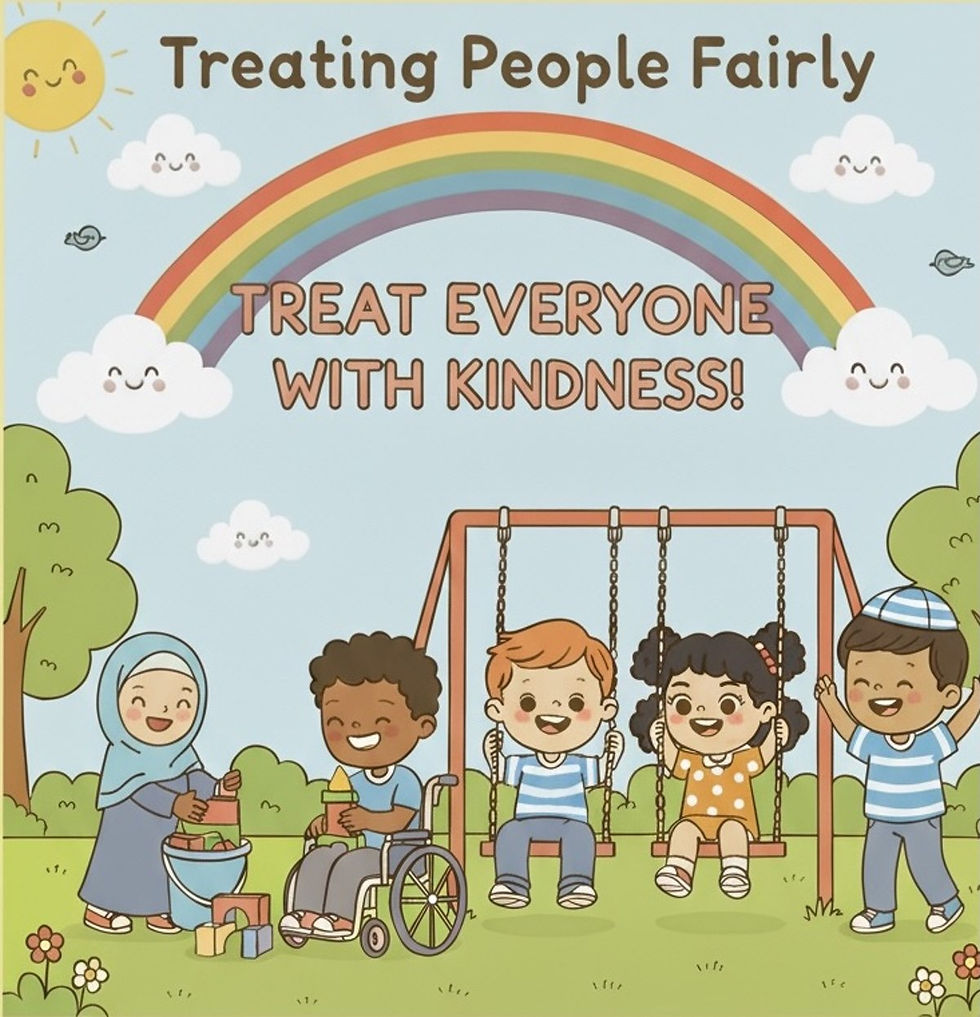Fair or Unfair? Let’s Talk About Justice
- Balance Learning Resources

- Oct 28
- 4 min read
Updated: Dec 17
Grade Level: 3-5
Duration of video 1: 1 minute, 58 seconds
Duration of video 2: 3 minutes, 19 seconds
Duration of video 3: 2 minutes, 27 seconds
Themes: Media literacy • Bystander‑to‑upstander skills • Practical sense of justice as fair action that raises dignity for everyone

Description:
Students watch three short, familiar movie clips that show examples of fair and unfair behavior. Using a child-friendly Justice Checklist, they decide what makes something fair and discuss how people can act in ways that are kind, safe, and fair for everyone.
Video 1: Zootopia: Judy & Gideon Fight. HD (1:58)
Video 2: A Bug’s Life (1998): Flik confronts Hopper (3:19)
Video 3: Wonder (2017) - My First Friend Scene (3/9) | Movieclips (2:27)
Lesson Plan:
🎯 OBJECTIVES (SWBAT):
Discuss the difference between fair vs. unfair.
Read and discuss 10 child-friendly criteria to analyze if a behavior is fair or unfair.
Analyze the behavior of characters in video clips using these 10 criteria; propose a rewrite that makes a scene fair.
Suggest fair, kind, and inclusive ways to solve problems.
🧰 MATERIALS:
Video 1: Zootopia: Judy & Gideon Fight. HD (1:58)
Video 2: A Bug’s Life (1998): Flik confronts Hopper (3:19)
Video 3: Wonder (2017) - My First Friend Scene (3/9) | Movieclips (2:27)
Chart paper/markers (to make 3 3-columned t-chart)
Student Worksheet 1: Justice Checklist (Printed for each student or digital copy)
Student Worksheet 2: Make It Fair (Printed for each student or digital copy)
📋 LESSON FLOW
Hook:
Write the words “Fair” and “Not Fair” on the board.
Ask students to define what is ‘fair’ and ‘not fair.’
Ask: What is a fancy word for ‘fair’ that starts with a letter 'j'? [Answer: Justice.]
Write the word “Justice” near the word “Fair” on the board. Discuss that justice means being fair, kind, safe, and truthful, so life gets better for everyone.
Connection:
Say: Today, we are going to learn about what makes something fair or not fair - just or unjust.
Hand out Student Worksheet 1: Justice Checklist (Print for each student or digital copy)
Read and Discuss: Student Worksheet 1: Justice Checklist with students. Explain that these are tools to determine if a situation is fair or unfair in stories and in real life.
Procedure
Teacher says:
“Keep your Justice Checklist on your desk while you watch the videos I will show you. Please look for fair and unfair behaviors. We’ll use the checklist to help us decide what we see.”
Watch Video 1: Zootopia: Judy & Gideon Fight. HD (1:58)
Ask students:
“Which fair or just behaviors did you see in this video?”
“Did you see any unfair behaviors? What were they?”
Hand out Student Worksheet 2: Make It Fair (Print for each student or digital copy).
Teacher models how to answer the questions about Video 1: Zootopia: Judy & Gideon Fight. HD on the Student Worksheet 2: Make It Fair.
Discuss:
“What did Gideon do that was unfair?” (Show students where to write this.)
“What did Judy do that shows how important it is to be fair?” (Show students where to write this.)
Watch Video 2: A Bug’s Life (1998): Flik confronts Hopper (3:19)
Tell students:
Refer to Student Worksheet 2: Make It Fair and ask students to check off the Justice Checkpoints (fair behavior) they saw in the video.
Tell students to turn-and-talk with a partner and continue to fill out Student Worksheet 2: Make It Fair for the questions that have to do with Video 2: A Bug’s Life (1998): Flik confronts Hopper.
Reunite class and briefly discuss answers.
Watch Video 3: Wonder (2017) - My First Friend Scene (3/9) | Movieclips (2:27)
Refer to Student Worksheet 2: Make It Fair, and ask students to check off the Justice Checkpoints (fair behavior) they saw in the video.
Ask:
“What was the unfair moment?”
“What was the fair choice here?"
“What would change if more kids acted like this?”
Tell students:
Turn and talk with a partner and continue to complete Video 3 Wonder (2017) - My First Friend Scene (3/9) | Movieclips section of Student Worksheet 2: Make It Fair with their partner.
Whole-Class Share:
After finishing all three videos, reunite as a class.
Ask:
“What does standing up look like without put-downs or harm?”
“In each movie, did the fair choice make life better for everyone (not just one side)?”
“How can you practice what you learned today at recess, lunch, or online?”
Encourage students to share at least one example from their worksheet aloud.
Exit Ticket / Assessment:
Ask students to complete this final reflection on an index card to hand in:
“Think of one unfair thing you’ve seen at school. Then, describe one fair action you can take to make the situation kind, safe, and fair for everyone.”
Extension: Ask students to draw themselves doing a fair action with a peer or family member. Hang up students’ art in the classroom.
Classroom Signage to Remember and Apply Lesson:
Teacher can make a poster of the “Justice Checklist” from Student Worksheet 1: Justice Checklist, have students sign and/or decorate it, and hang it up in the classroom.
© 2025-2026
All materials on this website are available for educational use under Creative Commons License CC BY-NC-ND 4.0. Educators may download and share the content with attribution, for non-commercial use and instructional purposes, and without modification. Embedding any materials within any website-whether educational, institutional, public, or private-is prohibited without prior written consent of Balanced Learning Resources. Unauthorized embedding or redistribution may violate copyright and licensing terms.

